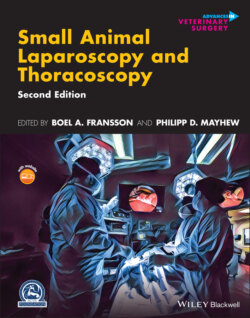Читать книгу Small Animal Laparoscopy and Thoracoscopy - Группа авторов - Страница 156
Key Points
ОглавлениеAnesthesia management requires the understanding of the physiological effects associated with abdominal insufflation and body positions often required for the laparoscopic approach.
Increased abdominal pressures and CO2 absorption through the peritoneum can significantly impact the cardiovascular and respiratory systems.
Specific patient positioning, such as the Trendelenburg (head‐down) and reverse Trendelenburg (head‐up) positions, can further impact venous return and cardiac output, as well as oxygenation and ventilation.
Albeit rare, an insufflation gas embolus to the heart is possible and can lead to cardiac arrest.
Ventilatory support and monitoring, including electrocardiography, capnography, pulse oximetry, and arterial blood pressures, is strongly recommended for patients undergoing laparoscopic procedures. Direct arterial blood pressure and blood gas analysis may be required in higher‐risk patients.
